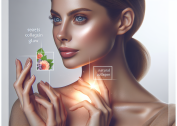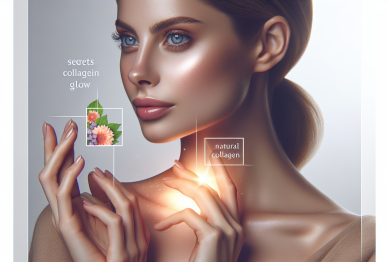Unlock the power of healthy, glowing skin by diving into proven skincare routines, trending ingredients, and myths debunked. This comprehensive guide shows how hydration, gentle exfoliation, and barrier repair can transform your wellness and beauty journey with long-term results.
Understanding What Makes Skin Glow
What does it really mean to have glowing skin? For many, it represents health, vitality, and even confidence. Scientifically, radiant skin has a smooth texture, even tone, and a hydrated, supple appearance. This appearance is influenced by genetics, environment, and lifestyle habits such as diet, sleep, and stress management. Research emphasizes that firmness and subtle luminosity stem from collagen and elastin levels, both crucial for youthful skin. Embracing naturally derived products and mindful habits plays a significant role in supporting your skin’s structure from within.
The biological basis of glowing skin starts at the cellular level. Regular cell turnover, healthy microcirculation, and an unbroken barrier all contribute. As we age, turnover slows and environmental stressors like pollution, UV light, and even indoor heating can deplete moisture and lead to dullness. Addressing these factors by choosing gentle cleansers and barrier-protecting moisturizers helps keep the skin resilient. Recent breakthroughs in skin science have clarified the importance of barrier repair and gentle supplementary actives for keeping skin luminous over time.
Many myths still surround what causes a natural glow. Some claim quick serums offer instant radiance, but the truth is, a long-term routine yields better results. Top dermatologists point out that hydration, sunscreen, and antioxidants form a reliable, evidence-based base for luminous skin. Focusing on healthy habits—like regular sleep, stress management, and balanced nutrition—sets the stage for improvement. It’s not about trend-chasing, but understanding what works beneath the surface to unlock your skin’s best potential.
The Power of Hydration and Its Benefits
Hydrated skin looks brighter and feels softer. Water is essential for every cell in the body, and skin cells are no exception. Dermatological studies highlight that moisturization helps the skin reflect light better, resulting in the coveted radiant glow. Ingredients such as hyaluronic acid draw water into the outer layers, increasing plumpness and resilience. Layering lightweight hydrating serums and creams can optimize this effect, even in harsh climates or with fluctuating humidity levels.
Besides topical hydrators, drinking enough water daily is equally important. While topical products help seal in moisture, internal hydration supports all body functions including skin cell turnover and toxin removal. Consuming water-rich foods like cucumber, watermelon, and leafy greens can further boost results. Research suggests that dehydration can lead to a rough, lackluster skin appearance. By prioritizing both internal and external hydration, not only will your skin’s texture improve, but you may also notice more pronounced clarity and elasticity.
Hydrators aren’t limited to water alone. Ingredients like glycerin, ceramides, and aloe vera provide additional moisture and help rebuild the natural lipid layer. Choosing the right moisturizer for your skin type—whether oily, dry, or combination—makes a noticeable difference. For those with sensitive skin or eczema, science-backed formulations with a focus on gentle humectants and emollients reduce the risk of irritation while maximizing glow. Explore options and listen to your skin’s needs for best effects.
Gentle Exfoliation: Uncovering the Glow
Gentle exfoliation is key for revealing brighter, smoother skin. As old skin cells accumulate, they create a barrier that reflects less light and feels rough to touch. Regular, mild exfoliation removes these cells, making way for new, vibrant skin underneath. Exfoliating acids like lactic and mandelic acid are gaining attention for their ability to smoothen without harshness. Mechanical scrubs can work if they’re not overly abrasive and are used with care.
Applying exfoliants too frequently or using formulas with large harsh granules can damage the barrier, causing sensitivity or breakouts. It’s best to start slowly—perhaps once weekly—and increase as your skin tolerates. Studies from leading dermatology journals confirm that exfoliation, done correctly, promotes better absorption of serums and moisturizers, enhancing your results. Sensitive skin types might prefer enzyme-based exfoliants from sources like papaya or pumpkin to achieve a similar effect with less risk.
Chemical exfoliants like alpha-hydroxy acids (AHAs) and beta-hydroxy acids (BHAs) can target specific concerns such as pigmentation, uneven tone, and clogged pores. Incorporating these ingredients strategically can provide visible luminosity over time. However, it’s crucial to always follow exfoliation with broad-spectrum SPF to protect the skin from heightened sun sensitivity. Consistency, rather than intensity, makes exfoliation a safe and effective way to achieve longer-lasting radiance.
The Role of Nutrition and Lifestyle Habits
The connection between diet and skin health is now well-supported by nutritionists and dermatologists alike. Consuming antioxidant-rich foods such as berries, dark leafy greens, and fatty fish floods cells with vital vitamins like C and E, which help reduce free radical damage. Omega-3 fatty acids found in salmon and flaxseed add plumpness and flexibility, creating a smoother canvas for the skin. Variety in the diet is key for obtaining a full spectrum of skin-supportive nutrients.
Other lifestyle habits can greatly impact skin’s natural glow. Consistent sleep helps the skin repair itself, and it’s during these hours that growth hormone supports collagen production. Chronic stress, on the other hand, may trigger breakouts, dullness, or even flare-ups of inflammatory conditions like psoriasis. Adopting stress relief techniques—such as yoga, mindfulness meditation, or daily walks—can benefit both your radiance and overall wellness.
Avoiding smoking and limiting alcohol intake also supports clearer, more resilient skin. Studies show tobacco smoke and excessive alcohol can dehydrate and age skin prematurely. Incorporate a wellness-focused routine with plenty of sunlight (while wearing SPF), gentle exercise, and conscious relaxation. These routines create an internal environment where the skin can renew, heal, and truly glow from the inside out.
Barrier Repair and Why It Matters
Beneath the visible surface, your skin’s barrier is responsible for protecting against irritants, allergens, and moisture loss. Healthy, glowing skin depends on an intact, functional barrier. The outer layer (stratum corneum) is made of cells held together by lipids, like bricks and mortar. When this structure weakens due to over-washing, harsh products, or climate, dullness and irritation quickly follow. Restoring lipids through ceramide- and squalane-rich products helps maintain a soft, radiant complexion.
Barrier repair products have advanced. Evidence suggests ingredients such as niacinamide, panthenol, and cholesterol can soothe, replenish, and fortify even delicate complexions. When the barrier is healthy, skin retains water more effectively, blushes less often, and is less prone to redness or breakouts. Dermatologists often recommend minimal routines during periods of barrier repair: a gentle cleanser, rich moisturizer, and daily sun protection. This simple practice yields lasting results.
Listening to your skin—identifying discomfort, dryness, or sudden breakouts—often points to a struggling barrier. Proactive repair can prevent escalating sensitivity and noticeable dryness. Swapping in fragrance-free formulas and avoiding over-exfoliation offers a recovery pathway. Once restored, reintroducing targeted actives like vitamin C or retinol can support both brightness and skin firmness, unlocking even greater glow in the long term.
Exploring Trending Ingredients and Treatments
Staying up to date on trending skincare ingredients can be both exciting and beneficial. Recent years have spotlighted compounds like niacinamide, bakuchiol, and peptides. Niacinamide is praised for its brightening and barrier-boosting effect, while bakuchiol offers a plant-based alternative to retinol. Peptides help stimulate collagen and deliver a firmer, more youthful complexion. Selecting these emergent actives based on your skin’s needs can add another layer of customization to your routine.
Professional treatments, like microdermabrasion and chemical peels, have become more accessible for those looking to accelerate their skin renewal. These procedures are supported by clinical trial data and can significantly improve texture and luminosity when supervised by certified specialists. Home devices, such as LED masks and sonic cleansing tools, continue to receive attention as potential adjuncts for boosting results. However, it’s important to prioritize healthy, consistent at-home skin care above all else.
Herbal and adaptogenic extracts—like centella asiatica and ashwagandha—are seeing renewed interest for their calming and anti-inflammatory properties. While not every trend will work for every skin type, it’s worth exploring new ingredients and formats as science advances. Consult clinician-led resources and evidence-based reviews before adding new components to your regimen. Wellness and beauty intersect powerfully when modern science and traditional wisdom come together for glowing skin.
References
1. American Academy of Dermatology. (n.d.). How to create an anti-aging skin care plan. Retrieved from https://www.aad.org/public/everyday-care/skin-care-basics/anti-aging/skin-care-plan
2. Harvard Health Publishing. (n.d.). The truth about skin health: What really works? Retrieved from https://www.health.harvard.edu/womens-health/the-truth-about-skin-care-what-really-works
3. Cleveland Clinic. (2022). How to Build a Skin Care Routine. Retrieved from https://health.clevelandclinic.org/how-to-build-a-skin-care-routine
4. National Institutes of Health. (2021). Nutrition and skin health. Retrieved from https://www.ncbi.nlm.nih.gov/pmc/articles/PMC3583891/
5. British Association of Dermatologists. (2021). Skin barrier function: What it is and why it matters. Retrieved from https://www.bad.org.uk/for-the-public/skin-cancer/skin-barrier-function/
6. Mayo Clinic. (n.d.). Beauty: From aloe vera to hyaluronic acid. Retrieved from https://www.mayoclinic.org/healthy-lifestyle/adult-health/in-depth/beauty/art-20047922









